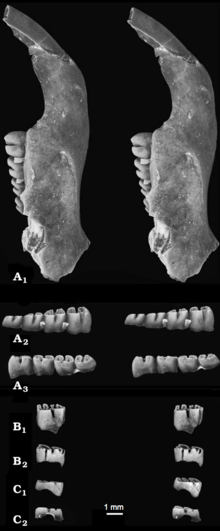| Apeomyoides | |
|---|---|

| |
| Jaw and teeth of Apeomyoides savagei, in stereopairs. A, holotype lower jaw (A1: labial view of jaw, A2: labial view of cheekteeth, A3: lingual view of cheekteeth). B, left first or second upper molar (B1: labial view, B2: lingual view). C, left deciduous fourth upper premolar (C1: labial view, C2: lingual view). | |
| Scientific classification | |
| Domain: | Eukaryota |
| Kingdom: | Animalia |
| Phylum: | Chordata |
| Class: | Mammalia |
| Order: | Rodentia |
| Family: | †Eomyidae |
| Subfamily: | †Apeomyinae |
| Genus: | †Apeomyoides Smith, Cifelli & Czaplewski, 2006 |
| Species: | †A. savagei
|
| Binomial name | |
| †Apeomyoides savagei Smith, Cifelli & Czaplewski, 2006
| |
Apeomyoides savagei is a fossil rodent from the Miocene of the United States, the only species in the genus Apeomyoides. It is known from fragmentary jaws and isolated teeth from a site in the early Barstovian, around 15–16 million years ago, of Nevada. Together with other species from scattered localities in the United States, Japan, and Europe, Apeomyoides is classified in the subfamily Apeomyinae of the extinct rodent family Eomyidae. Apeomyines are a rare but widespread group that may have been adapted to a relatively dry habitat.
As is characteristic of apeomyines, Apeomyoides was a large eomyid with high-crowned cheekteeth and a large gap between the incisors and cheekteeth. Furthermore, the cheekteeth—premolars and molars—approach a bilophodont pattern, with two distinct lobes. Other features distinguish Apeomyoides from other apeomyines, including the rectangular shape of the cheekteeth. The fourth lower premolar (p4) is larger than the molars behind it and has two roots, while the lower molars have three.
© MMXXIII Rich X Search. We shall prevail. All rights reserved. Rich X Search
